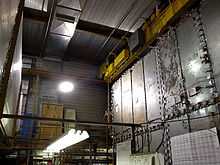Soudan 2

Soudan 2 was a particle detector located in the Soudan Mine in Northern Minnesota, United States. It was a 960 ton iron tracking calorimeter whose primary purpose was to search for proton decay, although its data was also used to investigate the properties of neutrinos. It found no evidence of proton decay, but it did help confirm Super-Kamiokande's atmospheric neutrino result, supporting the theory of neutrino oscillation.[1]
The Soudan Mine is also home to the MINOS and CDMS detectors.
History
Soudan 2 was the successor to the Soudan 1, a similar 30 ton detector also intended to search for proton decay.[2]
The excavation for Soudan 2 was done in 1984–1985. Installation was started in 1986 and was completed in 1993. The experiment was run from April 1989 to June 2001, beginning with a partial detector of 275 tons.[3] It was disassembled in 2005 to make room for further low background physics experiments, including MINOS.
External links
References
- ↑ "Current Aspects of Neutrino Physics", Caldwell, David O. (Ed.), 2001, ISBN 3-540-41002-3
- ↑ http://ccdb4fs.kek.jp/cgi-bin/img_index?8203219 "The Soudan Nucleon Decay Program", D.S. Ayres. ANL-HEP-CP-82-03, Presented at Workshop on Physics and Astrophysics with a Multikiloton Underground Track-Detector, Rome, Italy, 29-31 Oct 1981.
- ↑ http://www.slac.stanford.edu/spires/find/experiments/www2?expt=SOUDAN "Results From The Soudan Prototype Proton Decay Experiment", John Eric Bartelt (University of Minnesota). UMI-84-13752, Mar 1984. Ph. D. Thesis.
| |||||||||||||||||||||||||
| ||||||||||||||
